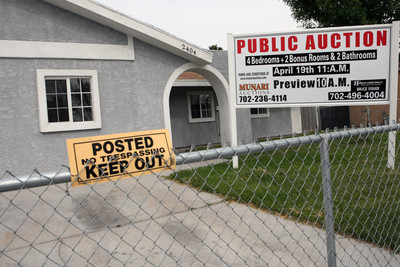Foreclosure aid focuses on Nevada, other states

WASHINGTON — The nation’s foreclosure crisis is centered in four states. But taxpayers across the country will feel the pain of bailing them out.
California, Florida, Nevada and Arizona generated about half of all foreclosure filings nationwide last year, according to RealtyTrac Inc., even though residents in those states hold just a quarter of U.S. mortgages. Since mid-2007, skyrocketing foreclosures in those states have been magnifying the national rate.
As lawmakers prepare to spend up to $100 billion in financial bailout money on a sweeping foreclosure prevention plan pushed by President-elect Barack Obama, the discrepancy is adding another layer to a problem already confounding economists, politicians and homeowners.
Just this week, RealtyTrac, an Irvine, Calif.-based foreclosure listing service, reported that more than 2.3 million American homeowners faced the loss of their homes last year, an 81 percent increase from 2007.
And Goldman Sachs chief economist Jan Hatzius said in a report that the number of unsold homes on the market is so large that prices are likely to keep falling by another 20 to 25 percent by mid-2010.
But there’s more to it than that. The Sunbelt states now in trouble are the same ones that for decades have taken jobs and residents from states in colder climates. Plus, states like California were also breeding grounds for toxic home loans. That state, after all, was home to some of the most notorious lenders such as IndyMac Bank, Countrywide Financial, New Century Financial and Golden West Financial, all of which have been shut down or acquired by other companies.
Now, in areas like Paramus, N.J., politicians are facing anger from borrowers who behaved more responsibly during the housing market’s boom years, and say they shouldn’t have to assist homeowners and lenders in other far-flung states that were anything but bastions of thrift and responsibility.
“They’re wondering: Why does the person who did things right end up having to subsidize … the person across the street who maybe did buy a house that was just too large,” said Rep. Scott Garrett, a New Jersey Republican, who has received numerous complaints from voters in his district in the northern part of the state.
Sen. David Vitter, a Louisiana Republican, led a failed effort to block the second phase of the financial rescue, arguing in part that spending billions to aid homeowners facing foreclosures sends the wrong message.
“Clearly, it’s a key problem in the economy; clearly, we need to try to address it responsibly,” Vitter said. “But I do have concerns about encouraging bad decisions, and folks who made good, conservative decisions having to subsidize bad decisions.”
Still, the Senate voted 52-42 Thursday to release the second $350 billion in the Treasury’s financial rescue fund following assurances that a healthy portion of it would be spent to try to reduce foreclosures, rather than aid banks, which helped gain the support of some skeptical lawmakers.
Many lawmakers have resisted giving banks more money, even as the Bush administration agreed early Friday to provide Bank of America with an additional $20 billion in support.
To be sure, not all foreclosures are in the four states dominating the numbers. There are other foreclosure hotbeds, including Minneapolis, Detroit, Cleveland and the Washington, D.C. suburbs.
And not all borrowers acted irresponsibly. Consumer groups say legions of borrowers were duped into loans that they didn’t understand, and deserve assistance.
Even in Los Angeles, where borrowers would benefit most from such aid, some homeowners don’t want to subsidize their more reckless neighbors. It’s the first question that Rep. Brad Sherman gets when hosting town hall meetings in his district in the San Fernando Valley.
Sherman, a Democrat, says that any recipients of government aid should have to share a portion of the profits when they eventually sell their homes. And he argues that regional foreclosure crises are causing collateral damage through the entire economy.
“Until the foreclosure disaster is solved, we’re going to be in a recession that will affect communities that have no foreclosures,” he said.
By contrast, in Vermont’s tiny hamlets, shady loans and foreclosures are rare. Banks there avoided exotic mortgages, like subprime or interest-only loans, and those that didn’t require proof of income, said Chris D’Elia, president of the Vermont Bankers Association. “We’ve very conservative, so we were putting people into the right products for their circumstances,” he said.
In Vermont, about 6 percent of all home loans were either overdue or in foreclosure as of last fall, compared with 10 percent nationwide and 11 percent in California, according to Mortgage Bankers Association data.
In North Dakota, the delinquency rate is even lower at 4.3 percent. The housing market is healthy, and no local bank has failed in nearly 18 years. The risky loans that were prevalent in Las Vegas and Phoenix are “just completely foreign” to North Dakotans, said David Flynn, an economics professor at the University of North Dakota.
Flynn often hears complaints about federal bailouts when he appears as a guest on a weekly radio show about business issues.
“There is a real strong sense of questioning: Why we are helping people who made bad personal financial decisions when there are others who made more appropriate financial decisions,” he said.
Still, the one thing economists and lawmakers agree on is that the housing crisis is worsening, as more people lose their jobs and can’t pay their bills.